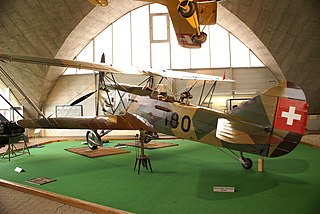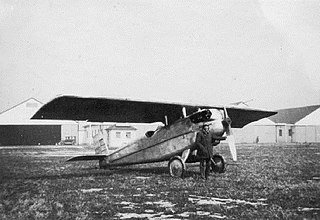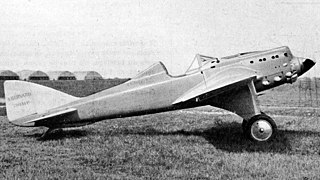| Hanriot H.35 | |
|---|---|
 | |
| Role | Intermediate training monoplane |
| National origin | France |
| Manufacturer | Avions Hanriot |
| Number built | 12+ |
The Hanriot H.35 was a 1920s French intermediate training monoplane designed and built by Avions Hanriot. [1] [2]
| Hanriot H.35 | |
|---|---|
 | |
| Role | Intermediate training monoplane |
| National origin | France |
| Manufacturer | Avions Hanriot |
| Number built | 12+ |
The Hanriot H.35 was a 1920s French intermediate training monoplane designed and built by Avions Hanriot. [1] [2]

The H.35 was developed from the earlier H.34 basic trainer and was a two-seat strut-braced parasol monoplane. [1] The H.35 was powered by a 180 hp (134 kW) Hispano-Suiza 8Ab piston engine. [2] Twelve aircraft were built for use with the Hanriot flying school and also the Societe Francaise d'Aviation at Orly. [2]
A 1925 development of the H.35 was the H.36 which was a twin-float equipped version powered by a 120 hp (89 kW) Salmson 9Ac piston engine. [2] An order for 50 H.36s was placed by Yugoslavia. [2]

Data from [2] Illustrated Encyclopedia of Aircraft
General characteristics
Performance

The CAMS 46 was a flying boat trainer aircraft built in France in the mid-1920s, essentially an updated version of the CAMS 30 that had flown in 1922. While retaining that aircraft's basic form, CAMS offered the French Navy two new versions with aerodynamic refinements over the earlier aircraft: the CAMS 46 E primary trainer, and the CAMS 46 ET intermediate trainer. Only the latter was selected for production and was built in quantity to supply one escadrille at the Naval training station at Hourtin.

The Gourdou-Leseurre GL-832 HY was a 1930s French light shipboard reconnaissance floatplane designed and built by Gourdou-Leseurre for the French Navy.

The EKW C-35 was a 1930s Swiss two-seat reconnaissance biplane aircraft built by the Swiss Federal Construction Works, Thun.

The Dornier Do H Falke was a German single-seat fighter, designed by Claude Dornier and built by Dornier Flugzeugwerke. Although an advanced design for its time, being evaluated by the United States Navy as the Wright WP-1, it did not go into production.

The Potez 32 and its military version the Potez 33 was a single-engine French monoplane transport built by Potez and based on the Potez 29 biplane.
The Morane-Saulnier MS.43 was a French two-seat training biplane designed and built by Morane-Saulnier for a 1924 French War Ministry requirement for an intermediate training biplane.

The Dewoitine D.513 was a 1930s prototype French monoplane fighter designed and built by Dewoitine.
The Avia 57 was a 1930s Czechoslovak 14-passenger commercial transport, designed by Robert Nebesář and built by Avia. The type was not a success.
The Avia 156 was a 1930s Czechoslovakian six-passenger commercial transport airliner for both mail and passengers, designed by Robert Nebesář and built by Avia. The type performed well but only one was built.

The Bernard SIMB AB 14 was a 1920s French single-seat sesquiplane fighter aircraft designed and built by the Société Industrielle des Métaux et du Bois (SIMB). With a reluctance of the French authorities to purchase monoplanes the Bernard 14 was designed as a sesquiplane with Y-form struts bracing the wings on each side. It was powered by a Hispano-Suiza 12Hb inline piston engine and had a fixed tailskid landing gear. While on a test flight on 22 February 1926 the aircraft suffered a catastrophic structural failure of the upper wing and the only Bernard 14 was destroyed.

The Bernard 20 was a 1920s French single-seat monoplane fighter aircraft designed and built by the Société des Avions Bernard. Originally displayed as a mock-up at the 1928 Paris Air Show it was a low-wing monoplane based on the Bernard V2 racer. The prototype powered by a 400 hp (298 kW) Hispano-Suiza 12Jb inline piston engine first flew in July 1929 from Orly. With its racing inheritance, in 1930 the aircraft flew at a speed of 280 km/h (174 mph). With the lack of interest by the French authorities for monoplanes the project was abandoned after 18 months of test flying.
The Bréguet 790 Nautilus was a prototype French three-seat coastal patrol flying-boat designed and built by Bréguet Aviation to meet a requirement from the French navy.

The Potez X was a French 1920s general-purpose colonial transport aircraft designed and built by Potez.
The Blériot 118 was a 1920s French amphibian flying-boat fighter designed by Léon Kirste, only one was built and it was not ordered into production.

The Bernard 82 was a French single-engined long-range monoplane bomber designed and built by Société des Avions Bernard. Only two prototypes were built and the type did not enter production.
The Blériot 195 was a French monoplane mail-carrier designed and built by Blériot Aéronautique, the one aircraft built was modified a number of times but failed to enter production.

The Loire 250 was a French single-seat fighter monoplane designed and built by Loire Aviation of St. Nazaire.

The Bernard H.V.120 was a 1930s French racing seaplane designed and built by Bernard to compete in the Schneider Trophy race. Delays caused by engine problems and the crash of the second aircraft delayed entry and the aircraft did not race in the competition.

The Wibault 360 was a 1930s French five-passenger airliner designed and built by the Wibault company.

The CAMS 36 was a 1920s French flying boat designed and built by Chantiers Aéro-Maritimes de la Seine. It was originally conceived as a single-seat fighter but evolved as a racer to compete in the 1922 Schneider Trophy race. Lack of funds in 1922 and an accident in 1923 meant the two aircraft built failed to participate in a Schneider race.
| Wikimedia Commons has media related to Hanriot H.35 . |